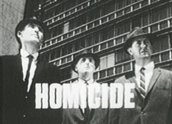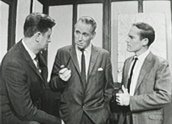


Homicide – The Decimal Point (1965)
Synopsis
What starts out looking like a straightforward crime committed in self-defence becomes a complicated double murder investigation and prompts homicide detectives to reopen an old file. One of the murder victims, a prison escapee, was a suspect in a robbery case that was never solved. A large stash of stolen money is still missing. The detectives suspect the hidden cash might be the motive for the murders and focus their investigation on the dead man’s suspected accomplices in the robbery.
Curator’s notes
Homicide was one of Australia’s earliest drama series and Crawford Productions’s first television cop show, produced in association with HSV7 in Melbourne (later Channel Seven). It came to be regarded as a breakthrough moment in Australian television, a hit drama series that created a demand for regular local drama programming in a medium previously dominated by US dramas. During its 12-year run, the series developed with the industry, reflecting changing technology, industry skill levels and an evolving ‘language’ of television.
‘The Decimal Point’ is episode 12, an example of the program in its earliest days. It combines scenes recorded on video in a studio with location scenes shot on film, an approach common in television in the ‘60s and ‘70s. Good quality dialogue recording was possible only in the studio-based sequences, the location-based sequences instead using narration. At the time this integration of studio and location scenes, film and video, represented an unprecedented level of complexity for its producers and for an Australian drama series. Crawford and HSV7’s previous courtroom drama series, Consider Your Verdict (1961–64), had been restricted to studio scenes, and the production’s video editing technology was very limited.
Different teams directed the film and studio scenes and there is a marked contrast between the two (see clip one and clip two). Studio scenes are dialogue heavy and limited in action. An early guide for Homicide writers recommends that ‘physical action is best handled on film. It is difficult, for example, to produce even a convincing fight in the studio’ – suggesting that the range of movement of studio cameras and the limits of the sets play a part here. In contrast, without dialogue to work with but more freedom in movement and framing, the location scenes demonstrate visual dynamism and experimentation with the possibilities of the form. At the same time though, their voice-over narration has a tone reminiscent of radio drama or narrated silent newsreels. This must have been an interesting time – audiences hungry for local content on television were prepared to suspend disbelief with this rather awkward style, all the while enjoying much more technically advanced Hollywood-produced fare.
While its style now looks quite dated, features of the episode were at the time quite revolutionary. The very fact of a local crime drama was a novelty. For Melbourne viewers, recognising their own suburbs as backdrops to a cop show was a first. Detectives with Australian accents was another innovation. In a 1964 interview, star Jack Fegan acknowledged the previous trend in Australian television dramas, most of them one-off ‘plays’, for actors to adopt international accents:
For ten years, I’ve been cast as an American or an Englishman … In Homicide, we don’t have to act, we’re playing real, and natural, Australians. Too often, when a play calls for an Australian, he’s the CJ Dennis type of character who nowadays is a rarity. We hope to be able to present the average Australian as he [sic] really is … a normal person who speaks and acts in a normal way.
The last part of the episode is a courtroom scene, a common feature in early Homicide episodes (see clip three). Possibly a carryover from the earlier Crawfords series Consider Your Verdict (1961–64), this early practice of concluding episodes in court was later dropped.
The episode title refers to Australia’s switch to decimal currency from the imperial monetary system (pounds, shillings and pence), which is part of the plot (see clip three). ‘The Decimal Point’ first screened on HSV7 in 1965. Homicide ran for 509 episodes, from 1964–75.
- Overview
- Curator’s notes
- Video 3 clips
- Principal credits
- Find a copy
- Make a comment
- Map
- Add your review



